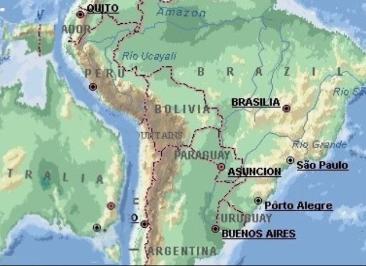
Topic: If the Pacific Ocean/Ring of Fire is subducting and the Pacific Ocean is shrinking as required by subduction, how is it possible that Australia was once connected to South America?

Most of the marsupials alive today are confined to South America and Australia.
http://en.wikipedia.org/wiki/Marsupial
There are about 334 species of marsupial, and over 200 are native to Australia and neighboring northern islands. There are also 100 extant American species; these are centered mostly in South America
Harrison, L., The Migration Route of the Australian Marsupial Fauna, Australian Zoologist, Volume 3, Pages 247-263, 1924
Briggs, J.C., The Ultimate Expanding Earth Hypothesis, Journal of Biogeography, Volume 31, Issue 5, Pages 855 - 857, 2004
McCarthy, Biogeographical and Geological Evidence for a Smaller, Completely-Enclosed Pacific Basin in the Late Cretaceous, Journal of Biogeography, Volume 32, Issue 12, Pages 2161 - 2177, 2005
"Biogeographic arguments for a closed Pacific (just like biogeographic arguments for a closed Atlantic and closed Indian) are based on evolutionary theory. Specifically, according to the theory of evolution, you can't have a host of closely-related, poor dispersing taxa suddenly appearing on opposite sides of an ocean -- when it is highly improbable for any of the ancestral taxa to cross oceans. So according to the referenced paper above, unless plate tectonic theorists want to rely on divine intervention, a slew of creation stories or a myriad of impossible trans-oceanic crossings of terrestrial taxa, their paleomaps are wrong. Panthalassa could not have existed between all of the hundred plus referenced taxa, which is to say, it didn't exist." -- Dennis McCarthy, biogeographer, 2003
Ali, J.R., Biogeographical and Geological Evidence or a Smaller, Completely-Enclosed Pacific Basin in the Late Cretaceous: a Comment, Journal of Biogeography, Volume 33, Issue 9, Pages 1670-1674, 2006
Briggs, J.C., Another Expanding Earth Paper, Journal of Biogeography, Volume 33, Issue 9, Pages 1674 - 1676, 2006
Ebach, M.C., and Tangney, R.S., Biogeography In A Changing World, 2007
"The present-day cordilleran system of eastern Australia was formed in still earlier times; it arose at the same time as the earlier folds in South and North America, which formed the basis of the Andes (pre- cordilleras), at the leading edge of the continental blocks, then drifting as a whole before dividing." -- Wegener, A., The Origin of Continents and Oceans, 1915
"All marine fossils from 200 million years ago or earlier are found exclusively on continental locations -- just as expanding Earth theory predicts. That's because all large marine environments pre-Jurassic were epicontinental seas -- not oceans. Incredibly, if we deny expanding Earth theory, all the pre-Jurassic oceanic marine fossils must have vanished, along with all pre-Jurassic oceanic crust, as well as all of the fossils of all the trans-Pacific taxa that simply "walked" from one location to the other. Hmmm. Even your mainstream fixist geologist counterparts of the first half of the twentieth century didn't have to accept that many miracles." -- Dennis McCarthy, biogeographer, 2003

